17 December 2003
Trails to these Burmese refugee camps in Thailand are long and difficult. Deeply rutted dirt roads wind through mountain jungles. The air chills. Trees and giant bamboo stretch five stories above our heads. Tropical songs of birds echo from the canopy.
The transmission of our truck groans as we climb a steep and narrow shelf. Where hidden springs trickle from cliffs, once hard-packed dirt forms oozing, slippery mud. Rainy season storms have washed-out sections here and there. Our truck wheels cross over the gaping valley floor on giant slabs of teak or bundles of bamboo.
Our downhill runs come with the scent of hot brakes and a rush of adrenalin as blind hairpin turns carry us precariously near the edge. The driver honks. A motorcyclist swerves to miss us. His bike is forced close against the gashed-open mountain side.
In valley floors, the road stops dead. We splash through shallow riverbeds, seeking out a gravelly trail among the
washed-down boulders. A kilometer or 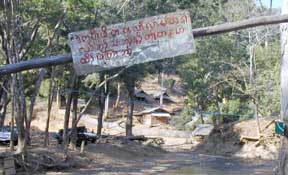 more away, we find the road again. It carries us up yet another mountain and another, deeper and deeper into this borderland jungle.
more away, we find the road again. It carries us up yet another mountain and another, deeper and deeper into this borderland jungle.
At the end, a pole with Burmese writing crosses our path. “Only persons with a
pass are permitted to enter the camp,” it says. Soldiers step out from their bamboo guardhouse and ask for our papers. The driver talks to them, lights a cigarette. Our papers are passed
around and inspected. Finally, one guard signs them and waves us through. Our four hour bone bruising journey has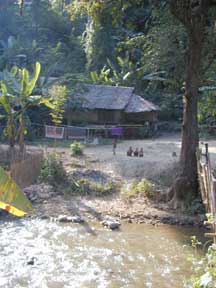 taken us to the camp of Mae Ra Moo.
Here and in other camps we are testing and interviewing young refugees for an NGO scholarship program. February through May twenty students will come to Chiang Mai for three months of courses in English, Thai, accounting,
public speaking, history, computer science, health and the course we will be teaching in leadership and management.
taken us to the camp of Mae Ra Moo.
Here and in other camps we are testing and interviewing young refugees for an NGO scholarship program. February through May twenty students will come to Chiang Mai for three months of courses in English, Thai, accounting,
public speaking, history, computer science, health and the course we will be teaching in leadership and management.
There are over 90,000 Burmese refugees living in camps along this border area of Thailand. Mae Khong Kha, the camp we visited yesterday, is in the middle of a forced relocation, insisted upon by Thai authorities. 17,000 people, stretched out along a narrow river valley salvage what they can, pack it into bundles, and hope it will find space on one of the occasional trucks carrying food and supply donations for camp residents. If not, they will have to carry it along a six day walk. Here in Mae Ra Moo, the Burmese border is less than one kilometer away. Another 15,000 people live here, all from the Karen State in Burma
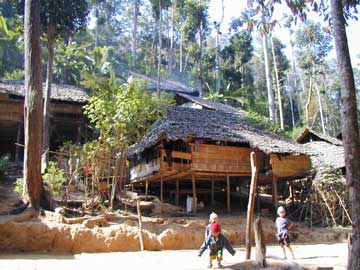 Refugee camps are divided into sections of about 1000-1500 people. Families live together in houses built from
available materials. Single men share a dormitory, as do single women. Aid agencies (the German Malteser Kreuz & IRC-International Rescue Committee) train etnic Karens as medics, assistants, and
health aides. Medication is dispensed. The sick or injured are cared for as much as resources allow. Medivacs do occur, but not by plane nor by helicopter. The road we took in is the road that
leads out. Survival is more a matter of fate, luck, or karma than of science.
Refugee camps are divided into sections of about 1000-1500 people. Families live together in houses built from
available materials. Single men share a dormitory, as do single women. Aid agencies (the German Malteser Kreuz & IRC-International Rescue Committee) train etnic Karens as medics, assistants, and
health aides. Medication is dispensed. The sick or injured are cared for as much as resources allow. Medivacs do occur, but not by plane nor by helicopter. The road we took in is the road that
leads out. Survival is more a matter of fate, luck, or karma than of science.
Until the British left Burma, Burmese people occupied and governed only the lower coastal areas of the country now called Myanmar. Other ethnic groups, like the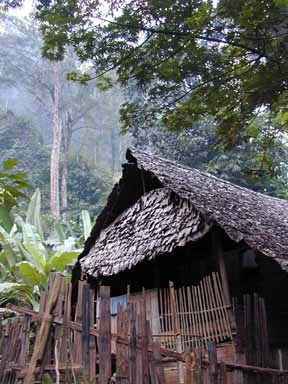 Karen, Karenni, and Shan, occupied various autonomous upland and
mountain regions in the north. Although, they were promised autonomy by Great Britain, the military regime that took over the country in the 1980s never respected this agreement. They imprisoned the
democratically elected government of Aung San Suu Kyi and have carried out ethnic cleansing since. Cool season raids by Burmese junta forces into ethnic states are well documented. Hill tribe
people still flee seasonal attacks, killings, rapes, and burnings of their villages. Some die or lose legs crossing the mine scattered border areas seeking refuge in Thailand. Others live grim lives as
displaced people within their own country.
Karen, Karenni, and Shan, occupied various autonomous upland and
mountain regions in the north. Although, they were promised autonomy by Great Britain, the military regime that took over the country in the 1980s never respected this agreement. They imprisoned the
democratically elected government of Aung San Suu Kyi and have carried out ethnic cleansing since. Cool season raids by Burmese junta forces into ethnic states are well documented. Hill tribe
people still flee seasonal attacks, killings, rapes, and burnings of their villages. Some die or lose legs crossing the mine scattered border areas seeking refuge in Thailand. Others live grim lives as
displaced people within their own country.
Some of those in the refugee camps of Thailand have been there for many years.
Some left families behind, where soldiers regularly enter villages, demanding the entire year’s rice crop, taking or killing pigs and chickens for junta troops. Farmers are conscripted to work as army
porters or unpaid laborers, digging the jewel mines or building roads and tourist resorts. Forced to abandon their families and farms, children are stolen or encouraged away to work in urban brothels.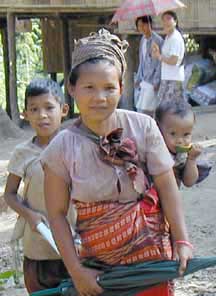
It is one thing to read data gathered by the UNHCR and NGOs or to read stories of Westerm writers who landed in a Burmese prison for photographing shackled slaves. It is something else, however, to sit across from a young woman as her grief clouds her face and to listen as she tells her own individual story. One lost a limb to a land mine. Another watched as his mother and father were shot by SPDC (Burmese junta) soldiers. Dozens sat helplessly by as a family member suffered and died for lack of health care. The ‘lucky’ ones tell stories of near starvation, of night time raids on their farms, of days and nights climbing jungle trails to escape the torturers of their lives.
“At that time the SPDC came in my village and capture all people.” Paw Htoo Coo (name changed for security) tells her story as tears well up in her eyes. ”They said if they avoided (sic) we will shoot the gun so we didn’t go anywhere. But their hearts were very cruel because suddenly they shot their gun at all my family. I cried and I hate the SPDC so much that I didn’t want to see their faces. Now I live alone and miss my parents very much.” Htoo Coo was only 12 years old when she witnessed the murder of her parents and siblings.
Here in Thailand, nearly a whole generation has grown up in the refugee camps. A whole generation has missed out on the higher education that was once the pride of Burma. Every one we spoke with dreams of going home.
For the most part, refugees say their lives are better than they were in Burma.
But camps are often placed on or near the Salaween river, bordering Myanmar and across from SPDC encampments. During the cool and dry seasons, refugee camps are subject to cross-border 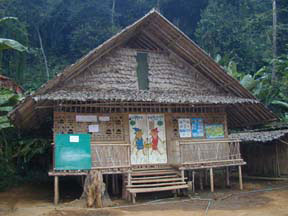 raids. Homes are burned; pigs and chickens
killed. When the SPDC is not a problem, mosquitoes are.
raids. Homes are burned; pigs and chickens
killed. When the SPDC is not a problem, mosquitoes are.
The rainy season virtually cuts camps off from the outside world. Roads are impassable. Flash floods claim houses and lives. Children and the elderly lay sick from malarial infections or dengue fever. Health care is limited.
In the best of times, electricity is minimal, produced by an occasional generator. Leaf roofs last 12 months. Bamboo structures, two years, so there is always work to do. Obtaining supplies not gifted by the jungle is difficult since refugees live under severe travel restrictions. Occasional trucks arriving from outside carry goods for disbursement or resale, but the ability to pay for goods is another matter.
People work for survival, not for luxury. The Thai government imposes high tariffs on camps engaging in any income-producing work, a policy that inhibits development of creative ideas and self-sufficiency. Paid workers, teachers for example, earn $125 dollars a year. “Better than nothing,” says Chubby, the Karen Further Education teacher in Mae Ra Moo.
He offered his home to us during our visit. The mat covered bamboo floor bowed against our weight. Two layers of grey, musty, woolen blankets covered our bodies. In the early night, the sounds of a woman singing came to us. Water splashed from a window. Exotic birds and monkeys and barking deer sang their evening songs. Between the sounds is stillness, a shadowed jungle silent, lighted by a brilliant canopy of stars. We wake early to morning chill, to quiet muffled talk and rising smoke. A child laughs. Roosters crow. A dog barks once, more from duty than from fear. Pans rattle as women prepare food from jungle garden vegetables added to donated supplies of rice, yellow beans, salt, oil, and sugar.
Except for times of forced relocation, refugees make these camps their homes. Vegetable gardens line the river. Homes grow fruit trees and flowers. Fish ponds are built. Pigs and chickens thrive. The refugees have their schools and clinics, churches and temples. Those who know something, teach others. Those who know more, train teachers. What they lack in education or skills, they learn in any way they can, from NGOs, from relief workers, from the stray tourist that wanders off their restricted backpack trail.
And democracy thrives. Leaders are chosen by election rather than at gunpoint. Leaders are chosen for camp and section administrations, for youth and teaching organizations. When there is a problem, people gather and organize. Opportunities for individuals are based on qualification and merit, not purchased by bribes or bought on the backs of slave labor. Our visit to Mae Ra Moo and Mae Khong Ka tells us that hope still exists for a free, federal democracy in Burma.
In this holiday season, we are the receivers of their gifts. They show us, yet again, how little worldly possessions have to do with dignity and happiness. They remind us of the power of hope and the strength of the human spirit. This is their gift to us and the one we wish to share with you.
Merry Christmas!
Norbert & Carol